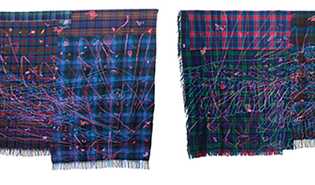 loading
loading
Arts & CultureTaking flightA textile work on display at the Art Gallery explores the celestial world of Iroquoian culture. Ned Blackhawk (Western Shoshone) is a professor of history, American studies, and ethnicity, race, and migration. He is the faculty coordinator of the Yale Group for the Study of Native America.  This powerful 2015 work in textile, by Marie Watt (Seneca) ’96MFA, is titled First Teachers Balance the Universe. The left wing is Part I: Things That Fly (Predator), and the right Part II: Things That Fly (Prey). The blankets are each more than eleven feet long and more than six feet high. (Their full span is not shown here.) They will be hanging in the Yale University Art Gallery through June 21—part of the exhibition Places, Nations, Generations, Beings: 200 Years of Indigenous North American Art. View full imageTwo monumental textiles by Seneca artist Marie Watt ’96MFA highlight the recently opened, student-curated exhibition Place, Nations, Generations, Beings: 200 Years of Indigenous North American Art on the fourth floor of the Yale University Art Gallery. The culmination of three years of work by student curators—Katherine Nova McCleary (Little Shell Chippewa-Cree) ’18; Leah Tamar Shrestinian ’18; and Joseph Zordan (Bad River Ojibwe) ’19—this exhibition draws from across Yale museum and library holdings to showcase incomparable works of Native American creative production. From contemporary photography to nineteenth-century weavings, from boarding school drawings to late-twentieth-century ceramics, this show marks, according to Yale University Art Gallery director Stephanie Wiles, a “milestone in the display and interpretation of Native American art at Yale.” The exhibition is the first major show of Native American art to be held at the gallery. It brings together over 90 pieces from across the extended Yale campus community and builds upon many student-led conversations about campus representations of Native Americans. Throughout this process, the curators successfully navigated multiple campus collections in developing the exhibition and drew primarily from the Gallery, the Beinecke Rare Book and Manuscript Library, and Yale Peabody Museum of Natural History. Within each, the curators accessed, analyzed, and often reinterpreted the collections of Native arts held within them, offering in the accompanying catalog the first detailed descriptions of most of these objects. Beautifully installed across the exhibition’s longest wall and visible from each spot of the show, the dual work First Teachers Balance the Universe by Marie Watt ’96MFA provides a centerpiece for the show. Assembled from dozens of repurposed woolen blanket squares and decorated with bright floss and thread, they contrast varied forms of textile materials and unite them into a shared aesthetic form. Installed slightly away from the wall, they hang close to the floor and gently flow within the room. Many observers might miss the motivations for placing these works in this first section. An internationally regarded Seneca artist who works heavily in textiles, Watt received her master of fine arts degree from Yale in a time before the 2013 opening of Yale’s Native American Cultural Center. At that time, the university provided limited institutional support for Native American students, community members, and campus members interested in Native American studies. Campus museums either ignored Native American art or had long participated in the intrusive, curatorial practices of “salvage ethnography” that had accompanied colonization. Informed by, and working against, such historical developments and erasure, the curators worked with gallery leaders to acquire works by Watt and to highlight the longstanding presence of “200 Years of Indigenous North American Art” on campus. They do so through the themes of “Place, Nations, Generations, Beings.” First Teachers Balance the Universe encapsulate each of these themes. Together, the curators’ catalog says, they embody “an immense set of wings and depict a surreal space inhabited by the herons, snipes, haws, and others who taught the Seneca’s first ancestor, Sky Woman, to live on Earth.” As members of the Six Nations of the Iroquois Confederacy, the Seneca have lived across Iroquoia in upstate New York for centuries. They participate actively in the Confederacy’s myriad forms of everyday political, economic, and social life and practice. Like the other nearly six hundred federally recognized Native nations, the Seneca practice the inherent forms of tribal sovereignty that govern their communities and their citizens. Emphasis upon such tribal “nations” informs much of the exhibition. Within Iroquoian society and culture, the celestial world remains full of historic and contemporary teachings, and themes of “place” particularly resonate across Watt’s work. The sky is full of multiple forms of animate and inanimate “beings.” In Part I: Things that Fly (Predator), a military aircraft appears to be tracking towards the eagle in Part II: Things that Fly (Prey). Tension between these inanimate and animate celestial powers bridges Watt’s two halves, as military technology threatens the most venerable inhabitant of the natural sky. The clash between colonized and colonizer appears partly muted by the inclusion of multiple community-made additions to Watt’s work. Throughout the creation of her work, Watt invites students, community members, and others to contribute additions to them, and dozens of smaller, threaded planes, satellites, birds, hot-air balloons, and other “beings,” are found throughout each side. A diversity of interactions above, Watt suggests, parallels a diversity of human relationships below. As many may know, blankets within Native American communities provide more than warmth and comfort. Historically traded across cultures, they bridge communities, cement relations, and bestow pride and honor. Parents to newborn children, couples in wedding ceremonies, and students upon graduation often receive such forms of communal recognition. Watt’s work thus highlights such themes of “generations,” themes that the curators prioritized throughout the making of the show and that resonated from their deep engagement with the place that was then their academic home.
The comment period has expired.
|
|